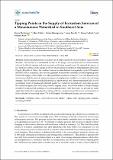| dc.description.abstract | Rubber plantations have expanded at an unprecedented rate in Southeast Asia in recent
decades. This has led to a substantial decline in the supply of ecosystem services (ESS) and has
reduced livelihood options and socioeconomic well-being in rural areas. We assessed the impact of
two land use scenarios on the supply of ESS in a mountainous watershed in Xishuangbanna Prefecture,
People’s Republic of China. We combined time-series data derived from spatially explicit ESS models
(InVEST) with a sequential, data-driven algorithm (R-method) to identify potential tipping points
(TPs) in the supply of ESS under two rubber plantation expansion scenarios. TPs were defined as any
situation in which the state of a system is changed through positive feedback as a result of accelerating
changes. The TP analysis included hydrological, agronomical, and climate-regulation ESS, as well
as multiple facets of biodiversity (habitat quality for vertebrate, invertebrate, and plant species).
We identified regime shifts indicating potential tipping points, which were linked to abrupt changes
in rubber yields, in both scenarios at varying spatial scales. With this study, we provide an easily
applicable method for regional policy making and land use planning in data-scarce environments to
reduce the risk of traversing future TPs in ESS supply for rubber producing land use systems. | en_US |

